Chapter: 12th Political Science : Chapter 10 : India and It’s Neighbours
India - Sri Lanka Relations
India - Sri Lanka Relations
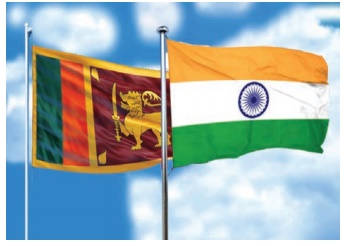
Since the Independence of India in 1947 and Sri
Lanka in 1948, both India and Sri Lanka enjoyed closer relations with each
other. Despite these closer relations, domestic developments in Sri Lanka has
always had a negative impact on each other relations. The main reason for this
negative impact is because of the ethnic crises between the Tamils and the
Sinhalese and the Indian response towards this issue. Security interests and
the shared ethnicity of Tamils living in southern India and in northern and
eastern Sri Lanka are the two major factors in Indo – Sri Lankan relations.
Ethnic Composition
According to the 1921 Census, there
were nearly 10 principal races, three pairs being subdivisions of larger
groups, in Sri Lanka (then known as Ceylon). Of these three were principal
races namely, the Low Country and Kandyan Sinhalese, the Ceylon and Indian
Tamils, and the Ceylon and Indian Moors. Four other specified races were the
Burghers, Eurasians, Malays and Veddas.
The predominant community Sinhalese,
which is about three-quarters of the population, are Buddhist and Speak
Sinhalese.
The Indian Tamils in Sri Lanka are also
largely Hindus. The Muslims mainly of Tamil origin speak both Tamil and
Sinhala.
Major Issues in India and Sri Lanka Relations
One of the first issues between India
and Sri Lankan began with the Ceylon Citizenship Act of 1948, where the
Plantation Tamils or Malayaha Tamizhar were deprived of their
citizenship.
Ethnic crisis in Sri Lanka has enormous impact on
India- Sri Lanka relations due to large Tamil speaking population in southern
India as well as the attempts by Sri Lanka to balance India’s influence with
the Tamils in Sri Lanka by building geo-strategic pressure by engaging the West
or the Chinese selectively. Sri Lanka is critical to India’s coastal security
and its interests in the Indian Ocean Region. Any presence of external powers
will hence have drastic impact on its defence and security.
Since the end of Eelam War IV, India – Sri Lanka
relations have been more constructive. In the recent years the bilateral trade
has increased manifold. Nevertheless there are few major concerns both
countries need to work out.
Return of Sri Lankan Tamil Refugees continues to be
a matter of concern. Unless, there is favorable political situation in Sri
Lanka, refugees will not return to their homeland.
The attack on the Indian fishermen continues and
has become a regular occurrence. There have been many suggestions to solve this
crisis, including deep sea fishing, lease in perpetuity of Katchatheevu,
alternate day fishing by Indian and Sri Lankan fishermen, etc., but sadly none
of these suggestions have seen the light of the day.
Sri Lankan Tamil Refugees Issue
In 1948, immediately after the country’s
independence, a controversial law labelled the Ceylon Citizenship Act was
passed in the Sri Lankan Parliament which deliberately discriminated against
the Tamils of South Indian origin, whose ancestors had settled in the country
in the 19th and 20th centuries.
This Act made it virtually impossible for them to obtain
citizenship and over 700,000 Tamils (consisting of up to 11% of the country’s
total population) were made stateless. In 1964, a pact was signed between
Bandaranaike and the then Indian Prime Minister Lal Bahadur Shastri to repatriate
much of the population of the stateless Tamils. Over the next 30 years,
successive Sri Lankan governments were actively engaged in deporting over
300,000 Tamils back to India. It wasn’t until 2003, after a state-sponsored
programme against Tamils and a full-scale civil war, that Indian Tamils were
granted citizenship but by this time, their population had dwindled to just 5%
of the country’s population. Tamils repatriated to India were assimilated with
location population after taking Indian citizenships.
Around 62,000 refugees, living in 107 camps across
Tamil Nadu, have been receiving various relief measures of the Central and State
governments. In addition, in recent years, the Tamil Nadu government has taken
steps for scores of young boys and girls of the refugee community to join
professional courses, particularly engineering. This has benefitted eligible
candidates among 36,800 non-camp refugees in the State too.
Change in status quo
At present, for both India and Sri Lanka, the
repatriation of refugees must be a priority. Tamil Nadu hosts the largest
number of Sri Lankan Tamil refugees in India. It would be in the interest of
both the countries to find the permenant resolution for this problem. While for
India a long-standing problem would be resolved, for Sri Lanka it would be a
step towards ethnic reconciliation.
The two governments can come out with a
comprehensive package on voluntary repatriation, after involving
representatives of the refugee community, the Tamil Nadu government and Sri
Lanka’s Northern Provincial Council.
For refugees who want to stay back, India can
consider providing them citizenship, as it did for refugees from Pakistan and
Afghanistan. This can be acheived by filtering out any potential anti-social or
anti-state elements, leading to the eventual closing down of refugee camps in
Tamil Nadu. Such a process will bring an end to an episode that has lasted
longer than the civil war of Sri Lanka.
Katchatheevu
Kachatheevu originally belonged to kings of
Ramanathapuram. NO maps of Sri Lanka showed it as its territory. However,
seeing it’s strategic location, Sri Lanka started claiming it. The issue was
discussed some times during the meeting between Indian and Sri Lankan leaders.
However in 1974 Indira Gandhi signed an agreement whereby Kachatheevu was given
to Sri Lanka. Katchatheevu is an uninhabited 285-acre island situated in
between India and Sri Lanka in the Gulf of Mannar. It has a Catholic shrine and
has been declared as a sacred area by the government of Sri Lanka. The shrine
attracts devotees from both the countries. This 1974 agreement had secured the
rights of Indian fishermen only to dry their nets and use the Church for
religious observance. But then in 1976, delimitation of International Maritime
Boundary Line (IMBL) was agreed upon as required by the UNCLOS. With this,
Indian fishermen do not have any right to even engage in drying of nets and use
of Church because 1976 agreement superseded 1974 agreement. Since then our
fishermen are facing innumerable problems.
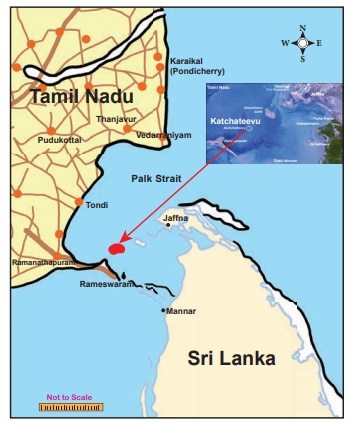
Nehru-Kotelawala Pact (1954)
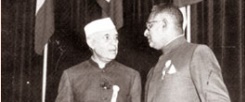
The Nehru-Kotelawala Pact was an
agreement that was signed between Jawaharlal Nehru, the Prime Minister of
India, and John Kotelawala, the Prime Minister of Sri Lanka, on 18 January
1954. It was an agreement regarding to the status and future of people of
Indian origin in Ceylon. They were brought by British from Madras Presidency in
British India to work in tea, coffee and coconut plantations of British Ceylon.
In the pact, India accepted in
principle the repatriation of Indian population in Ceylon. But Jawaharlal Nehru
only supported voluntary repatriation of those who accepted Indian citizenship.
India disagreed on Sri Lankan position that suggested granting Indian
citizenship to people, who failed to qualify for Sri Lankan citizenship.
Fishermen Issue
· According to Joint Working Group on Fisheries (JWGF)
data, 111 boats of Tamil Nadu fishermen and 51 Indian fishermen were in arrest
or detention in Sri Lanka’s Northern Province in 2019.
· Reasons include on-going disagreement over the
territorial rights to the island of Kachchatheevu, and the damaging economic
and environmental effects of trawling.
· Due to the dearth of multi-day fishing capability,
Indian fishermen cannot shift their fishing effort from the Palk Bay area to the
offshore areas way beyond the continental shelf.
· Also, due to a gradual drop in fish count in the
Indian waters, Indian fishermen are forced to wander into Sri Lankan waters as
the catch is insufficient here.
· In November 2016, an inter-ministerial delegation
discussed terms for a joint working group, but the Sri Lankan delegation rejected
India’s request for a three year grace period so that the government can assist
fishermen to move from bottom trawling fishing method to another sustained and
effective method.
Shastri – Srimavo Agreement, 1964
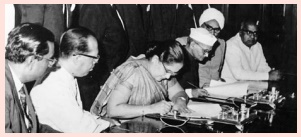
Mrs Srimavo Bandaranaike visited
India in 1964. After prolonged negotiations, an agreement was signed between
Bandaranaike and Shastri.
· It sought to solve the problem of 9 lakh
75 Thousand stateless persons in Sir Lanka using the following formula:
· 3 lakh people will get Sir Lankan
citizenship.
· 5 lakh 25 thousand will get Indian
citizenship. They were to move to India in a period spanning over 15 years.
· Remaining 1.50 lakh stateless persons
fate was to be decided later.
Rajiv – Jayawardene Agreement (Indo-Sri Lanka Accord), 1987
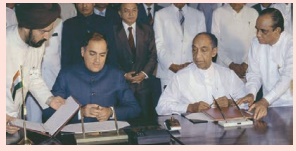
Diplomatic agreement between PM Rajiv
Gandhi and Srilanka President JR Jayawardane to solve the ethnic problem.
· An autonomous unit comprising
northern and eastern provinces (where Tamils are concentrated) would be
constituted.
· Elections to provincial councils were
to be completed by Dec 31, 1987 in the presence of Indian observers.
· Emergency was to be lifted from
northern and eastern provinces.
· Tamil, Sinhalese and English would be
official languages of Sir Lanka.
· Deployment of IPKF to guarantee and
enforce cessation of hostilities between Lankan army and Tamil militants.
Agreement was vehemently opposed by
Sri Lankans and an attack was attempted on Rajiv Gandhi when he was inspecting
guard of honour at Colombo airport.
India’s rehabilitation measures for Sri Lankan Tamils
The construction of 43,000 houses for resettlement
and rehabilitation of IDPs in Northern and Eastern Provinces is part of the
overall commitment to build 50,000 houses announced by Prime Minister Manmohan
Singh during the State visit of the President of Sri Lanka Mahinda Rajapaksa to
India, in June 2010, 47,000 have been completed until 2018. USD 350 million
grant to build the houses was one of the largest grants by India in any
country. Indian PM flagged off a train service at the north-western Sri Lankan
town of Talaimannar - the closest point to India - restored after decades of
civil war, completing the reconstruction of the entire Northern Province
Railway Line. Accompanied by Sri Lankan President Maithripala Sirisena, Modi also
unveiled a plaque inaugurating Talaimannar 1650 Pier Railway station.
The newly-constructed 63-km railway track is the
last segment of the 265-km long, prestigious Northern Railway Line
Reconstruction Project which is being executed by IRCON International Ltd., a
Government of India owned company.
During the period of Lal Bahadur Sastri’s
premiership an agreement was reached between the two nations in resolving the
issues of Indian origin Tamils.
India agreed to provide citizenship to two thirds
of the people of Indian origin; But the ethnic conflict between native Tamils
(Eelam Tamils) and the Singhalese erupted into a protracted civil war,
revolting a massive influx of Tamil refugees into India.
Way Ahead
· India can try to get back the island of
Kachchatheevu atleast on “lease in perpetuity” or by negotiations.
· Permit licensed Indian fishermen to fish within a
designated area of Sri Lankan waters and vice versa.
· There is a glaring need for institutionalisation of
fishing in Indian waters by the Government of India so that alternative means
of livelihood are provided.
· Government will have to mark up a comprehensive plan
to reduce the dependence of Indian fishermen on catch from Palk Bay.
If these social issues can be sorted out. India and
Sri Lankan can become prime movers in the regional polity.
Related Topics